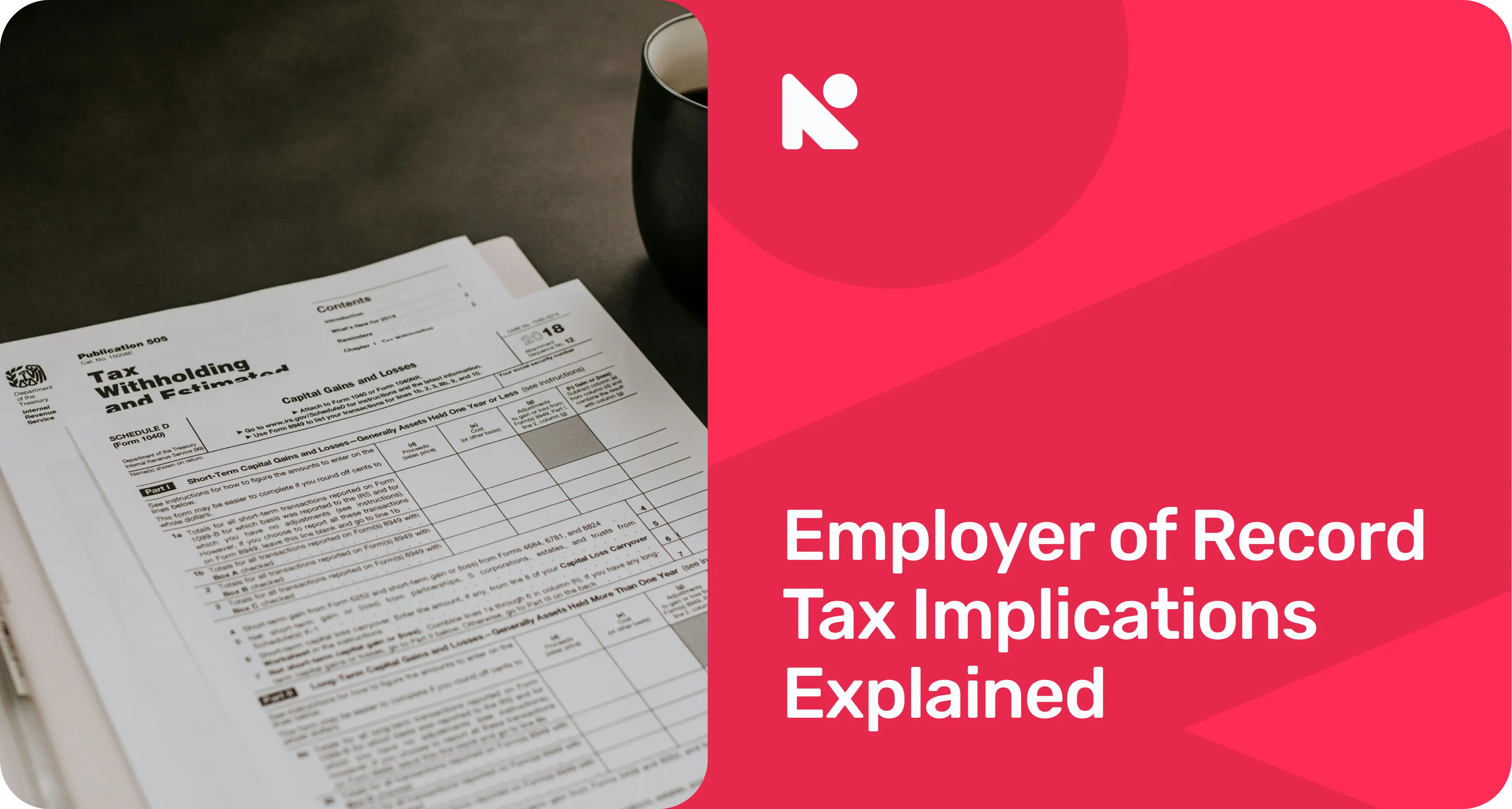Employer of Record Tax Implications Explained - 2025 Guide
Understanding employer of record tax implications is critical for businesses expanding internationally in 2025. With evolving regulations, stricter compliance checks, and rising enforcement around permanent establishment (PE), companies must ensure they remain compliant while scaling globally.
An Employer of Record (EOR) can simplify international hiring and payroll, but it does not remove all tax liabilities. This guide explains how EORs handle tax responsibilities, the benefits and risks associated with this model, and what businesses should know before relying on it.

What is an Employer of Record (EOR)?
An Employer of Record (EOR) is a third-party provider that legally employs workers on behalf of a client company. While the client manages the employees’ day-to-day tasks, the EOR takes care of administrative and compliance responsibilities. This typically includes:
- Payroll processing
- Withholding and remitting income taxes
- Managing employer-side taxes and contributions
- Ensuring compliance with local labour laws
By acting as the legal employer, an EOR enables businesses to hire in new markets quickly without setting up a local legal entity. You can learn more about this in our Employer of Record services page.
How EOR handles tax responsibilities
One of the most valuable aspects of an EOR arrangement lies in the way it manages taxes. Payroll taxes are handled directly by the EOR, which calculates, withholds, and remits income taxes on behalf of employees, ensuring that filings are correct and submitted on time. On the employer side, the EOR takes charge of mandatory contributions such as social security, healthcare, or unemployment insurance, depending on the jurisdiction.
This extends beyond payroll itself. Many EORs also oversee benefits administration, making sure that statutory coverage is not only provided but also compliant with local labour law. For businesses, this significantly reduces the administrative burden and provides peace of mind that payroll and related tax responsibilities are being managed accurately. Learn how this integrates with Native Teams’ global payroll solutions.
Responsibility | Managed by EOR | Notes |
| Payroll tax withholding | ✔ | Deducted from employee salaries and remitted to tax authorities |
| Employer contributions (social security, healthcare, etc.) | ✔ | Ensures compliance with statutory employer obligations |
| Employee income tax filing | ✘ | Employees may still need to file annual returns |
| Corporate income tax | ✘ | The company remains liable if activities create a Permanent Establishment |
Benefits of tax compliance & liability reduction
The most immediate benefit of using an EOR is the risk reduction. Tax compliance errors can be costly, leading to penalties, audits, and reputational harm. By relying on an EOR’s expertise, businesses are less likely to fall foul of filing deadlines or local requirements.
In addition, EOR arrangements can sometimes improve tax efficiency. Depending on the jurisdiction, employers may be able to access credits or incentives that they might otherwise miss. In the United States, for instance, businesses may qualify for Work Opportunity Tax Credit (WOTC) benefits when hiring eligible workers, and similar incentives exist in other regions. The ability to unlock these advantages while maintaining compliance creates an added layer of financial benefit.

Risks & Permanent Establishment (PE) exposure
It is essential to recognise that while EORs simplify compliance, they do not automatically eliminate all risks. The most significant is the possibility of triggering Permanent Establishment (PE). If employees engaged through an EOR are performing revenue-generating activities central to the business, tax authorities may classify the company as having a taxable presence in that jurisdiction.
Such classification can result in unexpected obligations, including corporate income taxes, double taxation, and even penalties for non-compliance. For businesses expanding abroad, this means that while an EOR offers short-term compliance advantages, careful assessment of employee activities is still essential. Our EOR guide to Permanent Establishment risk explores this issue in more detail.
Key tax considerations by jurisdiction
Employer of record tax implications vary significantly across borders, and businesses must remain mindful of jurisdiction-specific obligations. A company may still have corporate tax responsibilities if its activities amount to a permanent establishment, even if payroll is managed through an EOR. Employees, meanwhile, often have to file personal income tax returns in their host country, regardless of the fact that income taxes have already been withheld by the EOR.
Residency rules add further complexity, as long-term employees may automatically become tax residents in their country of employment. Double taxation treaties between countries may help offset this, but they require proper structuring and expert advice to be applied effectively. Businesses should therefore not assume that an EOR removes the need for local tax expertise and should consider leveraging Native Teams’ compliance insights to stay aligned with evolving regulations.

When to transition from EOR to a local legal entity
An EOR provides an excellent solution for SMEs or companies testing new markets, but it is not always suitable for long-term operations. As a business grows in a market and hires more employees, the cost-effectiveness of the EOR model can decrease. Beyond financial considerations, the risk of PE exposure increases when a larger workforce is engaged in significant commercial activities.
At this point, transitioning to a local legal entity can provide greater compliance control and stability. While establishing an entity requires time and investment, it allows a company to reduce PE risk, build deeper market integration, and operate with long-term certainty. Our guide to setting up entities vs. using an EOR outlines when this transition makes sense.
Real-world examples & use cases
To illustrate, consider a SaaS company hiring engineers across multiple jurisdictions. By using an EOR, the company avoided the need for separate payroll registrations in each country and maintained compliance with income tax requirements, freeing leadership to focus on product development. On the other hand, a fintech business that relied on an EOR to hire sales teams in Germany found that those activities triggered PE status, leading to unplanned corporate tax obligations.
In another case, a marketing agency relocating employees for short-term projects used an EOR to manage payroll and tax compliance in both home and host countries, ensuring that expatriate staff avoided double taxation complications. These examples show that while EORs bring clear compliance advantages, businesses must remain vigilant about the nature of work performed abroad.
Best practices & checklist for tax-savvy EOR use
The most effective way to utilise an EOR is to integrate it into a comprehensive compliance strategy. Businesses should begin by assessing potential PE risks before entering a new jurisdiction, paying particular attention to the types of activities employees will perform. Distinguishing between roles that are supportive in nature and those that generate direct revenue is key to avoiding unwanted exposure.
Regularly reviewing EOR contracts and assessing the number of employees in each jurisdiction also helps businesses decide when it is time to establish their own entity. Perhaps most importantly, companies should consult tax and legal experts before structuring international arrangements, ensuring that the EOR model complements their long-term expansion strategy rather than creating liabilities down the road.

Conclusion & next steps
Employer of Record tax implications in 2025 remain a crucial consideration for companies pursuing international growth. While EORs provide a strong foundation for payroll compliance, tax administration, and employee benefits management, they are not a silver bullet. Businesses must continue to monitor their exposure to corporate taxes and permanent establishment risks, adapting their structure as they expand.
The most effective approach is to treat EORs as a stepping stone, an efficient way to test new markets and grow teams, while preparing for the eventual move to a local entity where needed. To move forward with confidence, businesses should consult tax advisors, monitor scaling thresholds, and use EORs strategically. Discover how Native Teams can support your expansion while ensuring compliance at every step.
FAQs
What are the Employer of Record tax implications?
Using an EOR simplifies payroll tax compliance and reduces liability, but businesses may still face corporate tax obligations or PE exposure depending on employee activities.
Does using an Employer of Record eliminate tax liability?
No. An EOR manages payroll and employment taxes but does not eliminate all corporate or employee tax obligations.
How does an Employer of Record affect Permanent Establishment (PE) risk?
An EOR reduces compliance risks but does not eliminate PE risk if employees perform revenue-generating activities.
Are employees still responsible for their own taxes when hired through an EOR?
Yes. Employees may need to file personal income tax returns, depending on local laws, even if payroll taxes are withheld.
What are the benefits of using an EOR for tax compliance?
EORs ensure payroll accuracy, reduce compliance risks, and may unlock jurisdiction-specific tax credits.
When should a company switch from an EOR to setting up a legal entity?
Companies typically transition when they scale to a specific employee count, require greater compliance control, or want to reduce PE risk.
